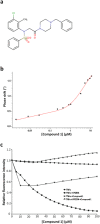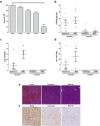Identification of an in vivo orally active dual-binding protein-protein interaction inhibitor targeting TNFα through combined in silico/in vitro/in vivo screening
- PMID: 28611375
- PMCID: PMC5469758
- DOI: 10.1038/s41598-017-03427-z
Identification of an in vivo orally active dual-binding protein-protein interaction inhibitor targeting TNFα through combined in silico/in vitro/in vivo screening
Abstract
TNFα is a homotrimeric pro-inflammatory cytokine, whose direct targeting by protein biotherapies has been an undeniable success for the treatment of chronic inflammatory diseases. Despite many efforts, no orally active drug targeting TNFα has been identified so far. In the present work, we identified through combined in silico/in vitro/in vivo approaches a TNFα direct inhibitor, compound 1, displaying nanomolar and micromolar range bindings to TNFα. Compound 1 inhibits the binding of TNFα with both its receptors TNFRI and TNFRII. Compound 1 inhibits the TNFα induced apoptosis on L929 cells and the TNFα induced NF-κB activation in HEK cells. In vivo, oral administration of compound 1 displays a significant protection in a murine TNFα-dependent hepatic shock model. This work illustrates the ability of low-cost combined in silico/in vitro/in vivo screening approaches to identify orally available small-molecules targeting challenging protein-protein interactions such as homotrimeric TNFα.
Conflict of interest statement
J.F.Z., R.R., and H.D. are shareholders of Peptinov S.A.S. L.D., H.D., H.M., and G.M. are employed by Peptinov S.A.S.
Figures





Similar articles
-
Discovery of highly potent TNFα inhibitors using virtual screen.Eur J Med Chem. 2014 Oct 6;85:119-26. doi: 10.1016/j.ejmech.2014.07.091. Epub 2014 Jul 25. Eur J Med Chem. 2014. PMID: 25078315
-
A novel small-molecule tumor necrosis factor α inhibitor attenuates inflammation in a hepatitis mouse model.J Biol Chem. 2014 May 2;289(18):12457-66. doi: 10.1074/jbc.M113.521708. Epub 2014 Mar 14. J Biol Chem. 2014. PMID: 24634219 Free PMC article.
-
Identification of novel inhibitors for TNFα, TNFR1 and TNFα-TNFR1 complex using pharmacophore-based approaches.J Transl Med. 2019 Jul 2;17(1):215. doi: 10.1186/s12967-019-1965-5. J Transl Med. 2019. PMID: 31266509 Free PMC article.
-
Modifying TNFalpha for therapeutic use: a perspective on the TNF receptor system.Mini Rev Med Chem. 2001 May;1(1):5-16. doi: 10.2174/1389557013407214. Mini Rev Med Chem. 2001. PMID: 12369987 Review.
-
Small-molecule inhibitors of the interaction between TNF and TNFR.Future Med Chem. 2013 Jan;5(1):69-79. doi: 10.4155/fmc.12.192. Future Med Chem. 2013. PMID: 23256814 Review.
Cited by
-
Inhibitors of protein-protein interactions (PPIs): an analysis of scaffold choices and buried surface area.Curr Opin Chem Biol. 2018 Jun;44:75-86. doi: 10.1016/j.cbpa.2018.06.004. Epub 2018 Jun 13. Curr Opin Chem Biol. 2018. PMID: 29908451 Free PMC article. Review.
-
Therapeutic potential of TNFα inhibitors in chronic inflammatory disorders: Past and future.Genes Dis. 2020 Mar 3;8(1):38-47. doi: 10.1016/j.gendis.2020.02.004. eCollection 2021 Jan. Genes Dis. 2020. PMID: 33569512 Free PMC article. Review.
-
In Silico Identification and Evaluation of Natural Products as Potential Tumor Necrosis Factor Function Inhibitors Using Advanced Enalos Asclepios KNIME Nodes.Int J Mol Sci. 2021 Sep 23;22(19):10220. doi: 10.3390/ijms221910220. Int J Mol Sci. 2021. PMID: 34638561 Free PMC article.
-
Design, Synthesis, and Evaluation of Dihydrobenzo[cd]indole-6-sulfonamide as TNF-α Inhibitors.Front Chem. 2018 Apr 4;6:98. doi: 10.3389/fchem.2018.00098. eCollection 2018. Front Chem. 2018. PMID: 29670876 Free PMC article.
References
Publication types
MeSH terms
Substances
LinkOut - more resources
Full Text Sources
Other Literature Sources
Miscellaneous

